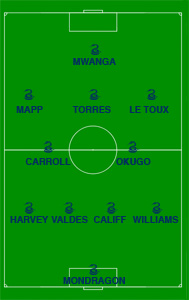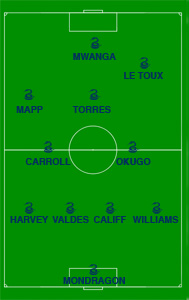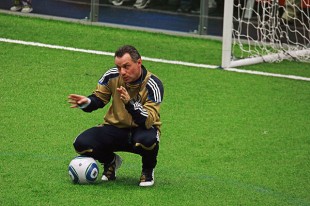New season. New faces. New roles. New tactics. As we move ever closer to the start of the 2011 season, the PSP takes a look possible tactical formations the Union might employ. Today, Mike throws out the idea of trying a 4-2-3-1 with two defensive midfielders creating possession and allowing lots of off the ball movement.
Adam delved into the basics of formations yesterday and pointed out that the Union primarily used a 4-2-2-2 most of last season. He also acknowledged that the Union have a wealth of central midfielders, a number of them more suited for a holding midfielder-type of roll. While Adam pitches a 4-1-3-2, I take that formation a step forward (or backward depending on how you look at it) and add another holding midfielder so that there is a line of two midfielders directly in front of the defenders, creating a 4-2-3-1. This may seem like a more defensive posture, but really it isn’t, it just allows for different roles in the offense for more players on the field. The 4-2-3-1 was the preferred system in the World Cup for 3 out of 4 semifinalists and is the system used by offensive juggernaut Barcelona.
It is three in the back sometimes.
With the release of Christian Arrieta yesterday, the Union only have two players that can be considered out-and-out outside backs: Sheanon Williams and Jordan Harvey. Michael Orozco Fiscal was one of the many players auditioned at right back, but he seemed more comfortable in the center and it wasn’t until late in the season that Williams burst on to the scene and really claimed the position. So there isn’t really much question who will be starting in the outside positions. The central positions are a little tougher to gauge with Philadelphia going out and signing Carlos Valdes last month as a potential fourth center back. In my line up, I have inserted Valdes next to Califf (who I think we can all agree will fill the other central role) simply because I believe the Union went out and signed him for a reason. While there did seem to be some chemistry between Orozco Fiscal and Califf by the end of last season, I still haven’t seen enough from Orozco Fiscal to say he is guaranteed a spot in the starting line-up this season.
The addition of Williams at the end of last season changed the right back position for the Union. He was much more willing than anyone else who had played there throughout the season to make darting runs out of the back and overlap the midfielders. In this formation, he will have to do same, as will Jordan Harvey to some extent on the left side. There will be a gap between the outside backs and the outside midfielders playing much higher up the pitch that will have to be covered by the outside backs at least some of the time, with the two defensive midfielders also patrolling this space.
The chances for Williams to attack from his outside position should be plentiful because of the coverage afforded with two holding midfielders. When he vacates that edge of the back line, Carroll or Okugo should be able to slide into that area. Even if Harvey pushes up the field as well, the Union should still have a solid back three of defenders with Califf, Valdes, and either Carroll or Okugo stepping back to play as a temporary back three.
As I mentioned earlier, you will see this a lot when watching Barcelona play. When they have the ball (which is very often), they switch to a back line of only three players. Sergio Busquetes starts as a central midfielder but often drops back to play on a line with Gerard Pique and Carles Puyol, allowing Dani Alves and whomever the left back is to push into the attack. This makes sense for the Union as well. Peter Nowak showed last year that he wanted to keep possession of the ball for stretches of the game and was less interested in a counter-attacking style. If the Union can maintain a solid percentage of possession, switching in and out of a back three could be very beneficial in allowing different players to link up throughout the field and confuse the defense of the opponents.
Out of all of these central midfielders, who do we play?
With no shortage of defensive minded central midfielders on the roster, the question becomes which ones start? In the 4-2-3-1 you could have some interesting pairings in that line. I have chosen Carroll and Okugo for now.
Carroll seems to be the safe bet for a lot of starts this season: he’s a player that the Union went out and acquired in the offseason, who has had success in a holding midfield roll on one of the best teams in the league that past few seasons, the Columbus Crew.
Okugo is a tougher pick. He showed spurts of quality play last year as both a defensive midfielder and a box to box type player. His tackling was strong, his passing range often exceeded that of Stefani Miglioranzi’s and he showed patience both on the ball and in making late runs into the box. But he also showed his inexperience with mistimed tackles and misfired passes. With one of the central midfielders having to drop into the back line occasionally, my choice for this role is Carroll. Okugo should be the player checking in for the ball often and then, hopefully, guiding it up field.
Depending on the opponent, Stefani Miglioranzi could be paired with Carroll in place of Okugo. Against a team that might want to keep more possession of the ball than the Union, Migs is an obvious choice as a more defensive minded player. You won’t see him streaking through the center of the park with the ball at his feet or even firing pinpoint 30 yard passes. But, he can force opponents into making bad decisions with the ball and win possession back for the Union. There are scenarios where Andrew Jacobsen (similar to Okugo’s role), Eduardo Coudet (can pick up the ball well from the defenders and advance up the field, usually on the dribble) and Kyle Nakazawa (playmaking ability and ability to shoot from distance) can also slot in.
Wingers, forwards, or midfieders? All three actually.
With the emergence of Sebastien Le Toux last year as a premiere forward in the MLS, a good solution to him being marked out of games this season would be to hide him a little bit. With both Le Toux and Mapp being able to play both sides of the pitch, it opens up opportunities for the three up field midfielders to interchange and keep moving constantly. I have inserted Roger Torres, who was pushed out on the wing a lot last season into the “center” of this trio. But the hope would be to have all three players changing positions constantly, with different players checking to the ball, moving into space on the flanks and even making late runs down the center of the park behind the opposing defense, a la Cesc Fabregas for Arsenal/Spain.
These roles are not without defensive responsibility, though. Mapp and Torres especially should be counted on for tracking back on defense. But with six players already behind them, their responsibilities will mostly include picking up late runners, especially from opposition outside backs. This might tend to push Le Toux into a role between the midfield and Danny Mwanga, creating what I am calling a lopsided 4-2-3-1. Le Toux’s role in that formation would resemble Arjen Robben’s role for the Dutch National Team in the World Cup: a winger/midfielder in terms of the chalkboard, but a player who will advance even higher than the lone striker when making runs up the field.
A lot of this will depend on Danny Mwanga
Mwanga was a revelation as a rookie last season, scoring seven goals. Many of those goals came while paired with either Le Toux or Alejandro Moreno as a striker partner in the 4-2-2-2. The 4-2-3-1 creates a different role for Mwanga. Instead of making runs up field, behind the defense and out to the wings, he will be required to check in to the midfield for the ball sometimes and, more importantly, be counted on to hold possession, allowing players to make runs beyond him. This wasn’t something the youngster excelled at last season, but it is a role I think he could play given some time. He will still have opportunities to make the runs of last season and stretch defenses, but he will counted on to control the ball at the top of the formation and allow for movement around him.
Possible substitutions and changes
The 4-2-3-1 allows for lots of slight adjustments to suit any circumstance during a match. If the Union are able to go up by a goal or two, a player from the line of three could be substituted for a more defensive player. If not starting, you could see Andrew Jacobsen or Stefani Miglioranzi brought on in place of Mapp or Torres. On the same token, if the Union go down a goal and want to push for more offense, Jack McInerney could be brought on for one of the holding midfielders to create a 4-3-3 with Jack, Le Toux and Mwanga to make a dangerous attacking trio. New signings Michael Farfan and Levi Houpeau would be available to slot in as traditional outside midfielders, or could even simply be injected as spark plugs on the line of three.
With the Union establishing themselves as a possession team last year, a formation like the 4-2-3-1 could make a lot of sense for the new season. It allows the team to keep the ball, but also allows for a lot of movement off the ball. While the possession was usually solid for Philadelphia last year, the vision in the final third seemed to be lacking in many games. A system that allows for much player interchange could allow for more chances in front of goal.





Any coincidence that your formation seems to preclude Jordan Harvey’s skill set?
Of all the recent tactical innovations, I think this one changes the most based on who plays in it. It could be very offensive if you have ball-moving center backs and hold the ball long enough to push your wide middies forward. Or it can be really negative, like it was for every team (Spain included, at times) in the World Cup.
Do the Union have a Sneijder or a Xavi or someone with at least the same idea of how to play midfield? I guess it would be Torres if anyone.
But what I like most about this formation is the way you hid Le Toux. That’s brilliant stuff.
I like this. I like that Torres and Okugo are in the starting eleven. I think Mwanga can do all this. He lost the ball a little too often last year because the game seemed to surprise him with its pace, but what I liked is that he was always confident of his ability to maintain possession via the dribble. I like Fiscal, but I agree that, with the draft, and the young talent, and Valdez being old, they must have got him thinking he’s a starter.
Valdes isn’t old, he’s 25. I’m old.
Oh. I’m old too.
Jordan Harvey does not have the correct set of skills to play in this system. Both Alves and Abidal have the speed, crosses, passing ability, and shots to make them effective in this role. Though Williams is no where near that level he has the proper skill set: speed and dribbling ability (the latter is a stretch I admit). This is the exact reason why losing Salinas hurt so badly. I know I am speaking in “ifs”, but this would rightfully be our set up if we had another Williams or Salinas to slide in on the left. At the moment we simply do not have a left back that can push up out of position and either have the speed or the tactical/technical abilities to be successful. I was rough on Harvey last year, but in hindsight I recognize that when he did not push up or try technical things he was a good defender. When he pushed up or tried something technical we got burned. I would love to see the Union run this set up, especially since Carroll is designed to slot in as that third CB, but Harvey is being asked to play a position that relies on his weaknesses rather than his strengths.
My partner and I absolutely love your blog and find many of your post’s to be exactly what I’m looking
for. Would you offer guest writers to write content for you personally?
I wouldn’t mind publishing a post or elaborating on some of
the subjects you write concerning here. Again, awesome site!